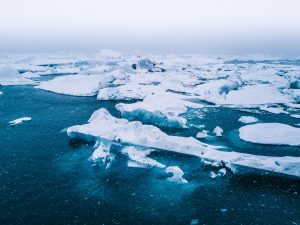By Nengye Liu

On January 26, 2018, China published its first ever Arctic Policy White Paper. The publication of China’s first Arctic policy was largely a response to international calls for transparency about China’s policy goals in the Arctic. It is a well-written document, and assures the Arctic states that China will follow existing international law applicable in the Arctic, so as to pave the way for China’s expanding presence in the region.
Nevertheless, nearly three years later, it is sad to say that the traditionally low-intensity, more cooperative Arctic is gradually becoming an arena for geopolitical competition between the United States and China. U.S. Secretary of State Michael Pompeo slammed China repeatedly during the 2019 Arctic Council Ministerial Meeting in Rovaniemi, Finland, warning about China’s challenge for the region. This was accompanied by the Trump administration’s approval to build more polar ice-breakers in 2020. In the meantime, China is becoming more and more active in the Arctic, such as opening up a new science observatory in Iceland in 2018, hosting the first Arctic Circle China Forum in Shanghai in May 2019, sending its second ice-breaker to the North Pole in 2020, and investing heavily in the Yamal LNG Project.
Why is U.S.-China competition intensifying after China published its Arctic policy? And why are concerns still being raised by other Arctic states about China’s intentions in the Arctic? Is it just because the Chinese regime cannot be trusted? I believe the reason goes deeper. Most suspicions about China’s role in the Arctic stem from the concern that China may break the rules. For example, even though most parts of the Arctic are already under national jurisdiction, it is popular to theorize that China would blatantly violate the United Nations Convention on the Law of the Sea (UNCLOS) and turn the Arctic into another South China Sea with extensive maritime claims.
The root of anxieties from Arctic states regarding China’s rise, which they may or may not be conscious of, is not about rules at all, but order. The existing rules-based order in the Arctic, underpinned by UNCLOS, has a hidden power structure. Within this power structure, the Arctic states take the drivers’ seat or “stewardship” role in governing the region, which should of course be the case. A rising China, a major power from outside the region, will inevitably shake the existing power structure. A shifting order may then be legitimized by the future development of international law.
This is already happening. For example, although the Arctic Council, where only the eight Arctic states have voting power, is the most important regional forum for cooperation, in the negotiations of the 2018 Agreement to Prevent Unregulated High Seas Fisheries in the Central Arctic Ocean (CAO Agreement), China was invited as a equal partner. This is because of China’s status as the world’s largest distant water fishing state. Without China’s participation, a legally binding instrument about fisheries in the Arctic high seas would not be most effective.
Therefore, as long as the Chinese economy keeps growing, and China continues to rise in the Arctic, suspicions, concerns, and push-back will remain, no matter how hard China may defend itself. This is why I am calling for China to start thinking about adopting an Arctic Policy 2.0. The 2018 Arctic Policy has done its job to justify China’s interests in the Arctic. Nevertheless, China now needs a new Arctic policy to elaborate its vision for the future governance of the Arctic – a vision that is not narrowly about China’s national interests, but truly about how China would contribute to build a better future of the Arctic. Below are two points to be considered for China’s potential Arctic Policy 2.0.
First, climate change is a major concern in the Arctic and a key justification for China to get involved in Arctic affairs. Indeed, the Arctic is suffering from human-induced climate change and witnessing fast melting permafrost and a collapsing ice shelf. In the meantime, China is the world’s largest greenhouse gas emitter, while facing significant challenges caused by climate change as well, such as extreme weather. China’s 2018 Arctic Policy vows to address climate change in the Arctic and to protect its vulnerable environment, but details are missing. In 2020 during the United Nations General Assembly, Chinese President Xi Jinping announced China is committed to be carbon neutral by 2060. This is a very ambitious move for tackling climate change. How would this impact the Arctic? Which kind of projects in China’s “Polar Silk Road” may help achieve this ambitious goal? Would Chinese investments in Arctic resources development conflict with China’s roadmap toward zero GHG emission? These are core questions that require some clarification in China’s Arctic Policy 2.0.
Second, sustainability is another key issue for the Arctic future. China has been emphasizing the need to achieve a balance between economic development and environmental protection in the Arctic. This is reflected in the CAO Agreement negotiations, where China talks about “rational use.” Like the term “sustainable development,” however, “balance” is a word subject to potentially opposing interpretations. What exactly does China mean by balance? This is not only about high sea fisheries, but about almost all Chinese activities in the Arctic. Given the Arctic’s vulnerable ecosystem, it would be expected that a balance between use and protection should be shifting toward the environment.
In short, I believe it is time for China to begin preparing a Arctic Policy 2.0, in order to shed light on which kind of order China would like to construct in the Arctic using its rising power. If China, the world’s second largest economy, can deliver a vision based upon a re-imagination of the human-nature relationship, with support of a concrete plan, it will not only help drive the Arctic toward a peaceful and sustainable future, but also benefit China’s own rise in the region.
No comments:
Post a Comment